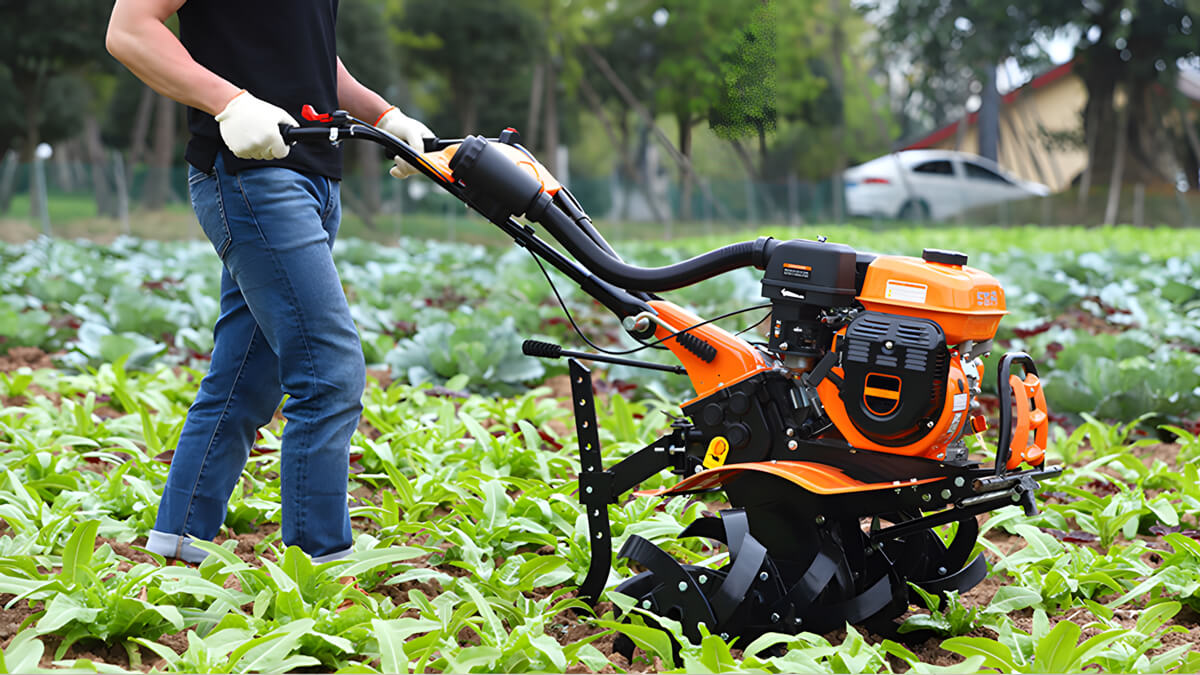how to use a rototiller
A rototiller is a powerful tool for soil preparation in gardening, landscaping, and agriculture. It uses rotating metal tines to dig and turn the soil. This makes the ground looser and easier to work while helping water and nutrients reach plant roots more efficiently. They are particularly useful for breaking up hard ground and preparing new vegetable garden beds, which can significantly reduce manual labor and save time.
Different models of rototillers have features such as adjustable tillage depth, forward or reverse rotating tines, and self-propelled to improve their performance and ease of use on various soil types.
In this article, you will learn how to use a rototiller. Used safely and effectively, it can create an ideal soil bed for successful planting. Read on to learn more.

Preparing for a rototiller
Operating a rototiller is physically demanding, so it is vital to ensure safety when using this powerful tool. Poorly planned tilling can result in uneven ground, poor soil conditions, and ineffective weed control. Taking the necessary steps before you begin can ensure that your garden or planting area is primed for healthy plant growth.
Wear the right safety gear
Safety always comes first when operating any machinery. Be sure to wear:
- Protective clothing: Long pants and closed-toe shoes or steel-toe boots to protect your legs and feet from debris.
- Gloves: Sturdy gloves can protect your hands from cuts, vibrations, and rough surfaces.
- Safety glasses or goggles: Protect your eyes from dust, mud, and flying debris.
- Hearing protection: Gasoline-powered rototillers are noisy, so use earplugs or earmuffs to reduce the noise.
These precautions can help protect you from injury and ensure a safer operating experience.
Assess soil condition
Before using a rototiller, always assess the condition of the soil. Soil that is too dry will be difficult to loosen, while soil that is too wet will compact rather than loosen, resulting in poor aeration and drainage. Ideally, soil should be like a wrung-out sponge—moist but not soggy.
To test the soil condition, grab a handful of soil and squeeze it. If the soil breaks up easily, it is ready to till. If the soil is too dry, water it lightly the day before tilling. If the soil is too wet, wait for the soil to dry out to avoid clumps.
If the ground is very compacted, consider making multiple shallow tillage passes and gradually increasing the depth to reduce the burden on the tiller and improve tillage results.
The best time to use a rototiller is in spring or early fall, when the soil is naturally moist but not waterlogged. Spring tillage prepares the soil for new crops, while fall tillage helps loosen compacted soil and mix in compost or organic matter before winter sets in.
Clear the area
Before you start tilling, check the area to make sure it is free of obstructions and hazards that could damage the rototiller or cause an accident.
Remove visible debris: Clear the area of rocks, sticks, garden tools, and trash.
Trim vegetation: Cut back tall grass and weeds. For stubborn weeds, consider using an herbicide or manually removing them ahead of time.
Check underground utilities: Be careful of underground pipes, wires, or sprinkler systems. If you are unsure, contact your local utility service.
Ensure a safe environment: Keep children and pets a safe distance from the area when using a rototiller.
Mark out boundaries
Marking out the area to be tilled helps maintain an orderly, efficient tilling process and makes the work easier and more precise.
Mark out the area: Mark out the boundaries using stakes and rope, a garden hose, or spray paint. This ensures that you are tilling within the designated tilling area.
Divide large areas into zones: If you are working in a larger space, divide it into manageable areas to keep the work organized and ensure even tillage.
Adjusting tilling depth
The correct tilling depth is critical for soil preparation.
For new soil: Tilling depths of 6 to 8 inches are recommended to loosen compacted soil and incorporate organic matter.
For re-tilling: A depth of 3 to 5 inches is usually sufficient to freshen up an existing garden.
Adjust based on soil type: Hard soils may require multiple shallow tillings to reach the desired depth.
Plan a tilling pattern
A good tilling pattern ensures even soil preparation and avoids missing areas.
Basic pattern: Back and forth tilling: Start at one end of the area and till in long, straight rows, overlapping each tilling slightly to ensure even coverage.
Circular motion: For smaller areas, start in the center and till outward in a spiral. This method is ideal for small spaces.
Diagonal tilling pattern: For larger areas, tilt the rototiller 45 degrees from the usual direction to loosen compacted soil. Then make a second diagonal tilling stroke to further loosen the soil.
Tilling in two directions – front to back and then diagonally – helps ensure that compacted soil is loosened at an even depth.
Dealing with hard soil: For hard soil, start with shallow tillage and gradually increase the depth, but make sure you don’t overload the tiller.
Steps to use a rototiller
Proper use of a rototiller ensures efficient soil preparation and minimizes damage to the machine and soil structure. Follow these steps to ensure safe and efficient tilling:
Check the rototiller
Before use, always check that the machine is in good working order:
Fuel and oil levels: Make sure the fuel and oil levels are adequate on gasoline models. Top up if necessary.
Teeth: Check for damage or wear and make sure they are securely attached.
Controls: Verify that all controls (throttle, clutch, gear setting) are functioning properly.
Start the rototiller
For gasoline-powered models: Turn the fuel valve to the “on” position. Set the throttle to low, close the choke, and quickly pull the starter cord. Once the engine starts, adjust the throttle to the desired speed and close the choke if it runs smoothly.
For electric models: Plug in the power cord or make sure the battery is fully charged. Press the start button or switch to begin operation. When starting, the machine is slightly above the ground to avoid shaking. After it runs smoothly, gently lower it into the soil.
Rotavator operation
Stand upright and steady with both hands firmly in place to control the rotavator. Walk at a comfortable pace and let the rotavator work naturally. Use the handle (if equipped) to guide the rotavator and turn gradually as needed.
First tillage
Depending on your tiller model, press the clutch lever or throttle control to engage the teeth. Slowly guide the tiller forward so that the teeth can dig into the soil, but do not use too much force. For compacted soil, start with shallow tillage of 2 to 1.5 inches, and then make multiple tillages, gradually increasing the depth.
Keep the tillage rows straight and parallel and overlap each tillage slightly to ensure even soil coverage. Avoid sharp turns to prevent uneven tillage or machine damage. For larger areas, divide the tillage area into several areas and till one area at a time.
Second tillage (if necessary)
After the first tillage, check the soil. If the soil still feels too coarse or has not been loosened to the desired depth, make a second tillage. This time, till in the opposite direction (perpendicular to the direction of the first tillage) to further break up the soil particles and create a finer, more uniform texture.
Turning and stopping
To turn the tiller, release the throttle or clutch lever to disengage the tines, then slowly turn the machine in the desired direction. Always make wide turns to avoid stressing the machine.
To stop the tiller, simply release the throttle or disengage the tines. If using a gas-powered model, shut off the engine and allow it to cool before storing. For electric models, unplug the power cord or turn off the battery. Clean the tines after use to remove dirt or debris and prevent rust.
Reduce fatigue and injury
Take regular breaks to relax your muscles and avoid fatigue. Alternating tilling with other gardening tasks can reduce overexertion. If you begin to feel tired, stop and take a break. Driving while tired can cause mistakes, injuries, or loss of control of the machine.
Common mistakes to avoid
Using a rototiller may seem simple, but some common mistakes can lead to improper soil preparation, machine damage, or personal injury. Watching out for these mistakes can improve tillage efficiency and extend the life of your machine.
Overloading the machine
Tilling too much soil at once can overload the rototiller’s engine and tine tips, causing them to stall, overheat, or even break down. Always till within a controlled range that allows the rototiller to do its job without applying excessive force. If the machine is struggling to operate, adjust the depth or speed, or make multiple tillage passes to avoid overloading.
Blockages
Clogs occur when soil, grass, or debris get stuck in the tine tips or engine area. Clean the tine tips and the machine’s engine after each use. If a machine becomes blocked while operating, stop immediately, turn off the engine, and carefully remove any debris. Always put safety first and never cleans up a blockage while the engine is running.
Improper tillage depth
Tilling too deep or too shallow can negatively affect soil quality. Tilling too deeply (more than 8 inches) can lift up poor subsoil, making it difficult for plants to take root. Tilling too shallowly (less than 3 inches) may not effectively loosen compacted soil. Adjust the tillage depth based on soil conditions and the type of job (whether you’re clearing new land or re-tilling an existing garden). If you’re unsure, start with a shallow setting and gradually increase the depth as needed.
Controlling speed
The speed at which your rototiller operates depends on soil conditions. For hard, compacted soil, slow down so the tines can penetrate. For softer soils or soils that are less aerated, speed can be increased. A steady, moderate speed is ideal, allowing the tines to work the soil properly.
Over-tilling the soil
Over-tilling can damage soil structure, leading to soil erosion and poor drainage. While loose soil is good for planting, over-tillage can disrupt the natural soil ecosystem. Till only, when necessary, such as at the beginning of the planting season or when preparing a new vegetable garden bed.

Conclusion
Rototillers are powerful soil preparation tools, but their effectiveness depends on proper use. By following the steps outlined in this blog, you can ensure safe and efficient tilling, resulting in healthier soil and better plant growth. Whether you are a beginner or an experienced gardener, using a rototiller correctly can simplify soil preparation and increase crop yields.
Regular maintenance, such as cleaning, oil changes, and tooth sharpening, will keep your rototiller in top condition, ensuring it lasts longer and works more efficiently.
If you need advice on choosing the right rototiller, or have any other questions, please feel free to contact us. We are here to help!









